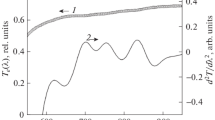Abstract
The change in the spatial distribution of the light scattering intensity during the development of the peak observed after temperature jumps in the glass transition range is experimentally investigated for phosphate and silicate glasses. The results obtained indicate the existence of interference effects in light scattering and a universal character of their manifestation in glasses of the systems under investigation. A qualitative analysis of the revealed specific features demonstrates that scattering regions undergo spatial changes in the course of the transient process.
Similar content being viewed by others
References
Bokov, N.A. and Andreev, N.S., Light Scattering by Sodium Germanate Glass after Temperature Jumps in the Glass Transition Range, Fiz. Khim. Stekla, 1999, vol. 25, no. 2, pp. 40–46 [Glass Phys. Chem. (Engl. transl.), 1999, vol. 25, no. 2, pp. 125–129].
Bokov, N.A. and Andreev, N.S., Specific Features of Light Scattering in Oxide Glasses in the Glass Transition Range, Fiz. Khim. Stekla, 2004, vol. 30, no. 1, pp. 9–19 [Glass Phys. Chem. (Engl. transl.), 2004, vol. 30, no. 1, pp. 6–13].
Bokov, N.A., The Features of the Visible Light Scattering by Oxide Glasses in the Glass Transition Region, in Proceedings of the XX International Congress on Glasses, Kyoto, Japan, 2004, Kyoto, 2004, CD-ROM, no. O-10-044.
Bokov, N.A., Effect of Temperature Gradient on the Intensity of Light Scattering in Phosphate Glasses in the Glass Transition Range, Fiz. Khim. Stekla, 2004, vol. 30, no. 5, pp. 531–535 [Glass Phys. Chem. (Engl. transl.), 2004, vol. 30, no. 5, pp. 390–393].
Andreev, N.S., Anomalous and Normal Light Scattering in Phase-Separated Glasses, Fiz. Khim. Stekla, 1978, vol. 4, no. 4, pp. 377–394.
Bus’ko, I.Zh. and Golubkov, V.V., Structural Regularities and Interference Effects in the Course of Relaxation Processes in Boron Oxide in the Glass Transition Range, Fiz. Khim. Stekla, 2003, vol. 29, no. 2, pp. 165–174 [Glass Phys. Chem. (Engl. transl.), 2003, vol. 29, no. 2, pp. 108–114].
Bus’ko, I.Zh., Golubeva, O.Yu., and Golubkov, V.V., Specific Features of the Kinetics of Structural Relaxation in Microinhomogeneous Glasses, Fiz. Khim. Stekla, 2006, vol. 32, no. 2, pp. 169–187 [Glass Phys. Chem. (Engl. transl.), 2006, vol. 32, no. 2, pp. 123–135].
Eskin, V.E., Rasseyaniye Sveta Rastvorami Polimerov i Svoistva Makromolekul (Light Scattering in Polymer Solutions and Properties of Macromolecules), Leningrad: Nauka, 1986 [in Russian].
Author information
Authors and Affiliations
Corresponding author
Additional information
Original Russian Text © N.A. Bokov, 2008, published in Fizika i Khimiya Stekla.
Rights and permissions
About this article
Cite this article
Bokov, N.A. Indicatrices during development of the peak of the light scattering intensity in the glass transition range of oxide glasses. Glass Phys Chem 34, 356–361 (2008). https://doi.org/10.1134/S1087659608040032
Received:
Published:
Issue Date:
DOI: https://doi.org/10.1134/S1087659608040032




